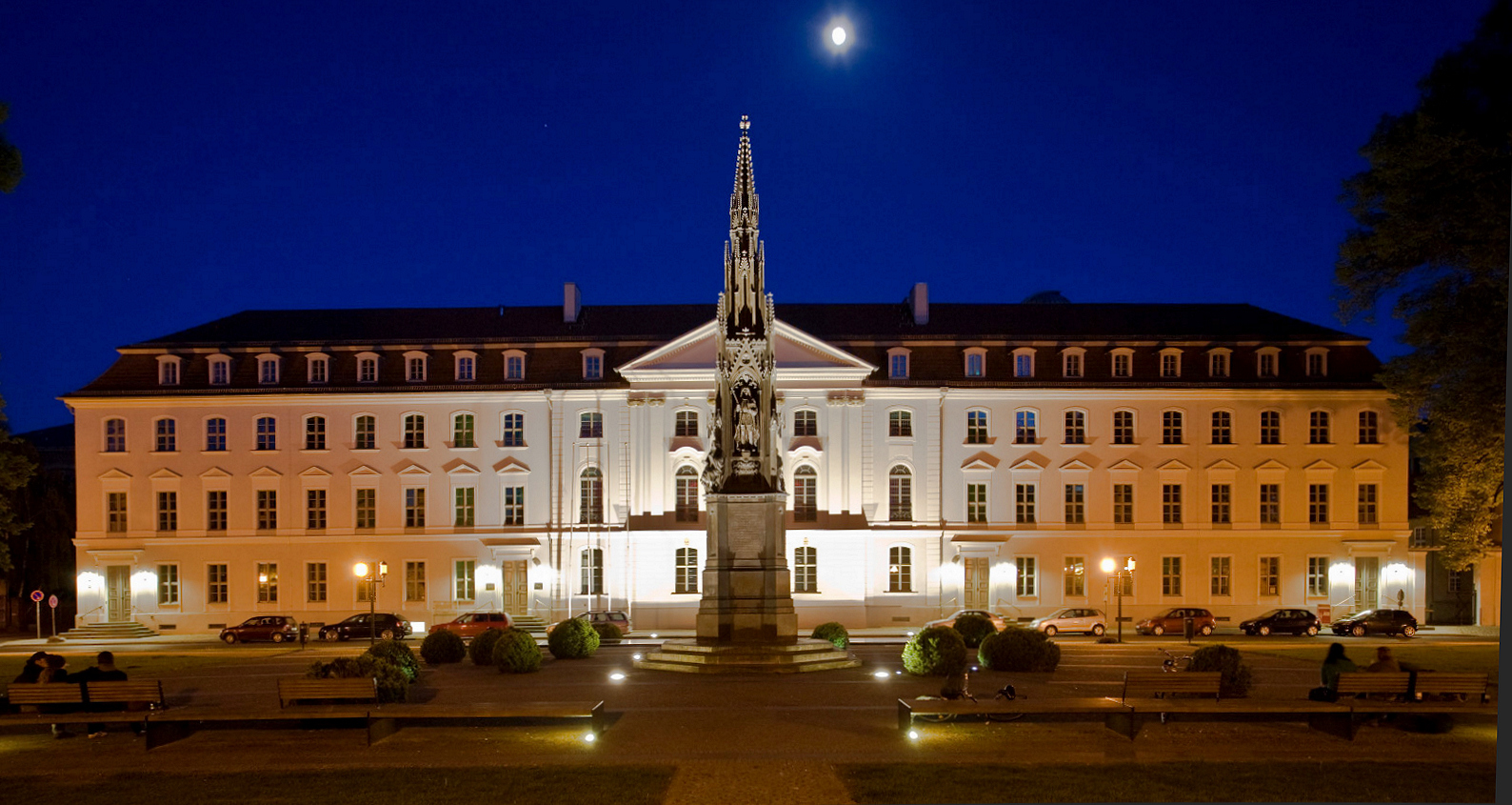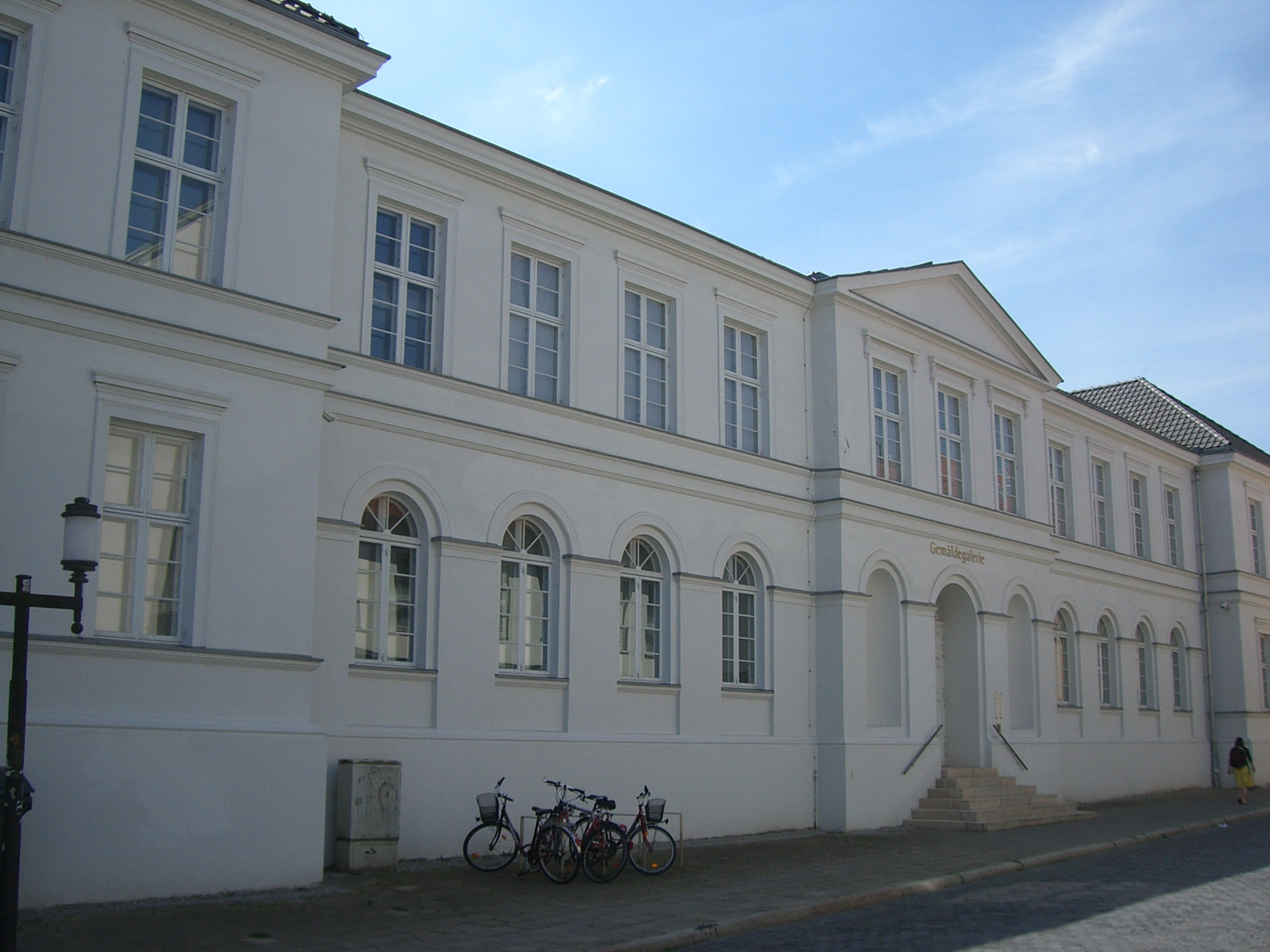|
Croÿ-Teppich
The Croÿ-Teppich (Tapetum Concordiae) is a 6.80 metre long and 4.32 metre tapestry, which is owned by the University of Greifswald. It is considered a unique cultural and historical testimony from the time of the Reformation due to its size, depiction and quality of execution. The work was commissioned by Duke Philip I, Duke of Pomerania in 1554 and made by Peter Heymans, a Dutch image weaver, in Szczecin or Jasenitz. The basse-lisse technique was used. On the carpet is a depiction of the Pomeranian Duke Philip I with his family as well as the family of his wife Maria of Saxony, Duchess of Pomerania, of the Course of Saxony Princely House on the occasion of the wedding. The figures are arranged below the preaching Martin Luther. Also in the background are the Protestant reformers Philipp Melanchthon and Johannes Bugenhagen. But not only the wedding is to be depicted, but also the longed-for unity of faith within Lutheranism in view of the disputes after the Augsburg Interim of ... [...More Info...] [...Related Items...] OR: [Wikipedia] [Google] [Baidu] |
Birgit Dahlenburg
Birgit Dahlenburg, ''née'' Handschel (16 April 1959 – 29 January 2017) thueringen-gedenkt.de was a German . She worked as custodian for the art collections of the and was instrumental in digitising art. Life Born in , she studied |
University Of Greifswald
The University of Greifswald (; german: Universität Greifswald), formerly also known as “Ernst-Moritz-Arndt University of Greifswald“, is a public research university located in Greifswald, Germany, in the state of Mecklenburg-Western Pomerania. Founded in 1456 (teaching existed since 1436), it is one of the oldest universities in Europe, with generations of notable alumni and staff having studied or worked in Greifswald. As the fourth oldest university in present Germany, it was temporarily also the oldest university of the Kingdoms of Sweden (1648–1815) and Prussia (1815–1945), respectively. Approximately two-thirds of the 10,179 students are from outside the state, including international students from 90 countries all over the world. Due to the small-town atmosphere, the pronounced architectural presence of the alma mater across town, and the young, academic flair in the streets, Greifswald is often described as a "university with a town built around it" rather ... [...More Info...] [...Related Items...] OR: [Wikipedia] [Google] [Baidu] |
Philip I, Duke Of Pomerania
Philip I of Pomerania (14 May 1515, in Stettin – 14 February 1560, in Wolgast) was Duke of Pomerania-Wolgast. Life Philip was the only surviving son of Duke George, from his first marriage to Amalie of the Palatinate. After his mother died, on 6 January 1525, he received his education at the court of his maternal grandfather in Heidelberg. He took office in Stettin at the age of 16, after the death of his father. On 21 October 1532, Philip and his uncle Barnim IX split Pomerania, with Philip taking Pomerania-Wolgast (Vorpommern). The division was initially limited to only nine years. It was, however, reconfirmed in 1541. His main advisors were Jobst von Dewitz, Rüdiger von Massow and his Chancellor, Nikolaus Brun. His secretary was the chronicler Thomas Kantzow. When he came to power, his first task was to sort out the relationship with his unloved step-mother, Margaret of Brandenburg. Under the marriage treaty of 1530, she was entitled to a specified part of his country a ... [...More Info...] [...Related Items...] OR: [Wikipedia] [Google] [Baidu] |
Heimo Reinitzer
Heimo Reinitzer (born 24 September 1943) is an Austrian athlete. He competed in the men's discus throw at the 1968 Summer Olympics and the 1972 Summer Olympics The 1972 Summer Olympics (), officially known as the Games of the XX Olympiad () and commonly known as Munich 1972 (german: München 1972), was an international multi-sport event held in Munich, West Germany, from 26 August to 11 September 1972. .... References 1943 births Living people Athletes (track and field) at the 1968 Summer Olympics Athletes (track and field) at the 1972 Summer Olympics Austrian male discus throwers Olympic athletes for Austria Place of birth missing (living people) {{Austria-athletics-bio-stub ... [...More Info...] [...Related Items...] OR: [Wikipedia] [Google] [Baidu] |
House Of Griffins
The House of Griffin or Griffin dynasty (german: Greifen; pl, Gryfici, da, Grif) was a dynasty ruling the Duchy of Pomerania from the 12th century until 1637. The name "Griffins" was used by the dynasty after the 15th century and had been taken from the ducal coat of arms. Duke Wartislaw I (died 1135) was the first historical ruler of the Duchy of Pomerania and the founder of the Griffin dynasty. The most prominent Griffin was Eric of Pomerania, who became king of the Kalmar Union in 1397, thus ruling Denmark, Sweden and Norway. The last Griffin duke of Pomerania was Bogislaw XIV, who died during the Thirty Years' War, which led to the division of Pomerania between Brandenburg-Prussia and Sweden. Duchess Anna von Croy, daughter of Duke Bogislaw XIII and the last Griffin, died in 1660. Name of the Dynasty The dynasty is known by two names, ''Pomerania'', after their primary fief, and ''Griffin'', after their coat of arms, which had featured a griffin since the late 12th centur ... [...More Info...] [...Related Items...] OR: [Wikipedia] [Google] [Baidu] |
Tapestries
Tapestry is a form of textile art, traditionally woven by hand on a loom. Tapestry is weft-faced weaving, in which all the warp threads are hidden in the completed work, unlike most woven textiles, where both the warp and the weft threads may be visible. In tapestry weaving, weft yarns are typically discontinuous; the artisan interlaces each coloured weft back and forth in its own small pattern area. It is a plain weft-faced weave having weft threads of different colours worked over portions of the warp to form the design. Tapestry is relatively fragile, and difficult to make, so most historical pieces are intended to hang vertically on a wall (or sometimes in tents), or sometimes horizontally over a piece of furniture such as a table or bed. Some periods made smaller pieces, often long and narrow and used as borders for other textiles. European tapestries are normally made to be seen only from one side, and often have a plain lining added on the back. However, other traditi ... [...More Info...] [...Related Items...] OR: [Wikipedia] [Google] [Baidu] |
Thomas Wünsch
Thomas Wünsch (born 21 August 1962) is a German historian. Life Born in Landshut, Wünsch studied history, philosophy and Slavic at the University of Regensburg from 1982 to 1988. After studying history, romance, philosophy and Slavic studies under and , he received his doctorate in 1991 with the thesis ''Spiritalis intellegentia. On the allegorical interpretation of the Bible by Petrus Damiani''. From 1991 to 1994, he worked as a historian at the Foundation House of Upper Silesia. He then worked as a research assistant to at the University of Konstanz from 1994 to 1998. There, he completed his habilitation in 1997 with a thesis on ''Conciliarism and Poland''. From 1998 to 2003, Wünsch was a university lecturer in general and East Central European history of the Middle Ages. Since 2003, Wünsch has taught Modern and Contemporary History of Eastern Europe and its Cultures at the University of Passau. He is a member of the and since 2004 co-editor of the ''Zeitschrift für Ostm ... [...More Info...] [...Related Items...] OR: [Wikipedia] [Google] [Baidu] |
Joachim Bahlcke
Joachim (; ''Yəhōyāqīm'', "he whom Yahweh has set up"; ; ) was, according to Christian tradition, the husband of Saint Anne and the father of Mary, the mother of Jesus. The story of Joachim and Anne first appears in the Biblical apocryphal Gospel of James. His feast day is 26 July, a date shared with Saint Anne. In Christian tradition The story of Joachim, his wife Anne (or Anna), and the miraculous birth of their child Mary, the mother of Jesus, was told for the first time in the 2nd-century apocryphal infancy-gospel the Gospel of James (also called Protoevangelium of James). Joachim was a rich and pious man, who regularly gave to the poor. However, Charles Souvay, writing in the ''Catholic Encyclopedia'', says that the idea that Joachim possessed large herds and flocks is doubtful. At the temple, Joachim's sacrifice was rejected, as the couple's childlessness was interpreted as a sign of divine displeasure. Joachim consequently withdrew to the desert, where he fasted ... [...More Info...] [...Related Items...] OR: [Wikipedia] [Google] [Baidu] |
Pommersches Landesmuseum
The Pomeranian State Museum (german: Pommersches Landesmuseum) in Greifswald, Western Pomerania, is a public museum primarily dedicated to Pomeranian history and arts. The largest exhibitions show archeological findings and artefacts from the Pomerania region and paintings, e.g. of Caspar David Friedrich, a Greifswald local, such as '' Ruins of Eldena Abbey in the Riesengebirge''. The museum was established in the years of 1998 to 2005 at the site of the historical Franziskaner abbey. Near Binz on the nearby isle of Rügen, a satellite of the museum is under construction at ''Jagdschloss Granitz Granitz Hunting Lodge (german: Jagdschloss Granitz) is located on the German island of Rügen in the vicinity of the seaside resort of Binz. With over 200,000 visitors per year it is the most popular castle or '' schloss'' in Mecklenburg-Vorpo ...'', a former hunting lodge of the Rugian princes. This branch will be designated to Rugian history. An early 20th century museum in ... [...More Info...] [...Related Items...] OR: [Wikipedia] [Google] [Baidu] |
Lübeck
Lübeck (; Low German also ), officially the Hanseatic City of Lübeck (german: Hansestadt Lübeck), is a city in Northern Germany. With around 217,000 inhabitants, Lübeck is the second-largest city on the German Baltic coast and in the state of Schleswig-Holstein, after its capital of Kiel, and is the 35th-largest city in Germany. The city lies in Holstein, northeast of Hamburg, on the mouth of the River Trave, which flows into the Bay of Lübeck in the borough of Travemünde, and on the Trave's tributary Wakenitz. The city is part of the Hamburg Metropolitan Region, and is the southwesternmost city on the Baltic, as well as the closest point of access to the Baltic from Hamburg. The port of Lübeck is the second-largest German Baltic port after the port of Rostock. The city lies in the Northern Low Saxon dialect area of Low German. Lübeck is famous for having been the cradle and the ''de facto'' capital of the Hanseatic League. Its city centre is Germany's most extens ... [...More Info...] [...Related Items...] OR: [Wikipedia] [Google] [Baidu] |
Anna Von Croÿ
Anna of Pomerania (also known as ''Anne de Croy et Aerschot'', ''Anna von Croy und Aerschot, Anna von Pommern'') (3 October 1590, Barth - 7 July 1660, Stolp) was Duchess-Consort of Croy and Havré, and allodial heiress of the extinct ducal house of Pomerania. She was youngest daughter of Bogislaw XIII, Duke of Pomerania and Princess Klara of Brunswick-Lüneburg. She was the last surviving member of the Griffins (Greifen). In 1619 she married Ernst von Croÿ (1588–1620), prince and duke of Croÿ (1583–1620), an imperial general, he would however die the following year. Ernst was the son of Charles Philippe de Croÿ (1549–1613), who was the only son of Philippe II of Croÿ by his second wife, Anna of Lorraine. Their son, Ernst Bogislaw von Croy (1620–1684), became the last Lutheran bishop of Kammin (now Kamień Pomorski). See also *House of Croÿ The House of Croÿ () is a family of European mediatized nobility, which held a seat in the Imperial Diet from 1486, a ... [...More Info...] [...Related Items...] OR: [Wikipedia] [Google] [Baidu] |






